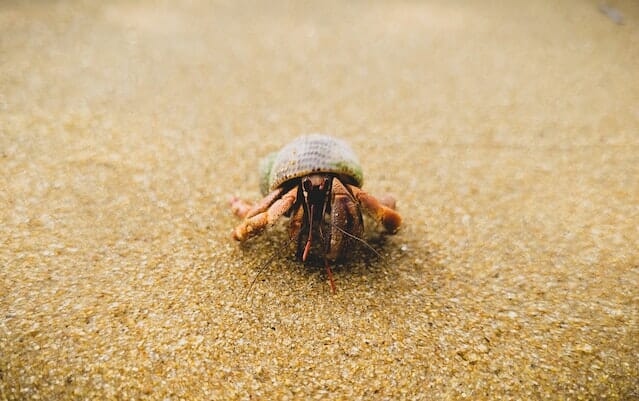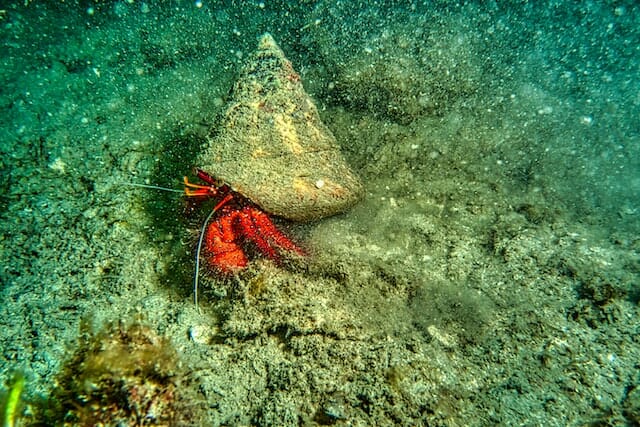Hermit Crab’s Personality: Their Behavior Towards Different Activities
Hermit crabs are gentle creatures and make great pets, but be sure you know how to handle them if they get agitated. They can be relied on to do tricks and fetch items but should always be supervised when given these opportunities as they may carry bacteria from one object to another. Hermit crabs enjoy human interaction but should only be handled if you have experience with them as they can bite easily if frightened or stressed.

Table of Contents
Different Types of Hermit Crab Behavior
Social Behavior
As social creatures, hermit crabs need companionship to feel happy. They live together in colonies of tens or even hundreds of crabs in their natural habitat. When defending their territory, hermit crabs will fight tooth and nail for what they believe is theirs.
Make sure you have the proper tank setup before getting a hermit crab – they need a tank that is large enough to roam around freely but has a lid that can be closed, so they are safe from other animals. They like to spend their time close to other hermit crabs to avoid being seen as a solitary island.
Digging Behavior
Hermit crabs are exciting creatures known for their defensive behavior and impressive digging speed! When threatened or harassed, hermit crabs often retreat into tunnels they’ve dug. These crabbies can dig pretty quickly, too, so it’s not unusual to see them scurrying away underfoot! Apart from being protective of their homes, hermit crabs enjoy spending time alone. They don’t socialize much and, as such, aren’t very well-known outside of specialist circles. However, when you meet one in the wild – be prepared for an exciting encounter!
Also, hermit crabs are known to eat a wide variety of items, including plants and animals. They have even been observed consuming small fish! The main reason for this eclectic diet is that hermit crabs need access to many different types of food to survive – which is something you can learn more about below!

Molting Behavior
Molting is a process that happens in many animals, including crabs. During this time, the crab is very inactive and will avoid contact with other crabs. Once the crab has molted, it will start behaving normally again and may become more social. The process of molting can be traumatic for the crab and cause behavioral changes that may last for several weeks. When a hermit crab needs to molt, it will retreat into its shell for up to several weeks.
Moreover, hermit crabs can also molt multiple times throughout their lifetime – so it’s essential to keep an eye on them and ensure they’re getting enough nutrition!
Grooming Behavior
The act of grooming is an essential part of hermit crab behavior. It helps them to stay clean and healthy and increases their chances of mating success. There are various reasons why hermit crabs groom each other – for example, to remove parasites or bacteria. They also do it as a form of social bonding. Grooming behavior can vary depending on the personality traits of individual hermits. Docile hermits groom less than aggressive ones, but this might change in response to stressors such as new surroundings or another crab invading their space!
Furthermore, hermit crabs are also known to consume small fish. This results from their diet – hermit crabs need access to various food items to survive. Fish keep them healthy and provide essential nutrients they can’t get from other sources.
Climbing Behavior
Hermit crabs are social animals that need interaction to stay healthy and happy. This activity, climbing behavior, help them stay fit and agile, helping them evade predators and explore their surroundings. Additionally, it forms a bond between the crab and its colony’s other members, strengthening the social network within the group.
In addition, hermit crabs can use their climbing ability to escape danger. For example, if they’re being chased by a predator or trying to reach a new destination in their colony.
Feeding Behavior
Providing your hermit crab with the right food is crucial to keep them healthy and happy. The best way to do this is by feeding them things that resemble their natural diet, including small fish, shellfish, and insects. Make sure you hand-feed them as they don’t like being handled aggressively and may bite if they feel threatened. If you’re worried about their safety, try placing a hiding place near where they feed so that they can rest undisturbed while eating.
However, hermit crabs are not aggressive creatures and will generally avoid confrontation if they don’t feel threatened. Therefore, you may not need to feed them as frequently as other types of pet crabs.
Hermit crabs are gentle animals that do well in captivity, provided they have the right environment and diet. However, their personality can change depending on factors such as stressors or new surroundings – so it’s essential to keep an eye out for any changes!
Aggressive Behavior
Hermit crabs are social animals and will interact with others if they are in the same tank. This aggressive behavior is to protect their territory and food. While it can be a bit strange for humans, hermit crabs make for an entertaining watch as they figure out who’s boss!
Nevertheless, if you see your hermit crab acting aggressively, it is essential to take action. This could mean separating them from the other crabs in their tank or removing potential threats.
Chirping Behavior
Anyone who has ever owned a pet knows that animals communicate with each other through chirping. Chirping is a vocalization many animals use to communicate their needs or emotions. In the case of hermit crabs, chirping serves as an essential social signal and early warning system. Hermit crabs use chirping to find one another and stay in touch with family members while away from home. They also use it as an alarm when danger approaches or when food is available. Chirping can be heard up to three meters away!
In addition, hermit crabs can use chirping to communicate their mood. When a hermit crab is happy, it will usually chirp louder than when it is angry or scared.